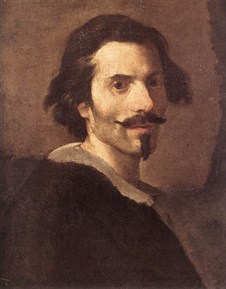Gian Lorenzo Bernini
 Gian Lorenzo Bernini (1598-1680) can be considered the major exponent of Baroque art in Italy in the seventeenth century. Born in Naples, he moved to Rome with his parents in 1605. His talent was obvious already in his group of four marble statues sculpted between 1619 and 1625, for Cardinal Scipione Borghese: Enea e Anchise (Aneas and Anchises), Il Ratto di Proserpina (The Rape of Prosperina), David e Apollo (David and Apollo) and Dafne (Daphne). He became a veritable symbol of Baroque art and culture. Under the pontificate of Urban VIII (1623-1644) Bernini became an artist of the first order in the Roman context, as is demonstated by his celebrated work in the Basilica of Saint Peter’s, like the bronze Baldachin and the elliptical colonnade. Among the architectural works of art there are Palazzo Barberini, Palazzo di Montecitorio, Palazzo Chigi and the projects for the palace of the Louvre (Bernini went to France in 1665). The two famous fountains in piazza Navona and in piazza Barberini are also his. Among his vast sculptural production we recall the tombs of Urban VIII and Alexander VII, the portraits of Costanza Buonarelli and Gabriele Fonseca, l’Estasi di Santa Teresa (The Ecstasy of Saint Teresa) and Beata Ludovica Albertoni.
Gian Lorenzo Bernini (1598-1680) can be considered the major exponent of Baroque art in Italy in the seventeenth century. Born in Naples, he moved to Rome with his parents in 1605. His talent was obvious already in his group of four marble statues sculpted between 1619 and 1625, for Cardinal Scipione Borghese: Enea e Anchise (Aneas and Anchises), Il Ratto di Proserpina (The Rape of Prosperina), David e Apollo (David and Apollo) and Dafne (Daphne). He became a veritable symbol of Baroque art and culture. Under the pontificate of Urban VIII (1623-1644) Bernini became an artist of the first order in the Roman context, as is demonstated by his celebrated work in the Basilica of Saint Peter’s, like the bronze Baldachin and the elliptical colonnade. Among the architectural works of art there are Palazzo Barberini, Palazzo di Montecitorio, Palazzo Chigi and the projects for the palace of the Louvre (Bernini went to France in 1665). The two famous fountains in piazza Navona and in piazza Barberini are also his. Among his vast sculptural production we recall the tombs of Urban VIII and Alexander VII, the portraits of Costanza Buonarelli and Gabriele Fonseca, l’Estasi di Santa Teresa (The Ecstasy of Saint Teresa) and Beata Ludovica Albertoni.
